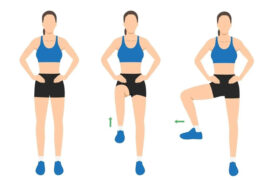To reduce heart attack risk and strengthen your lungs, focus on a heart-healthy lifestyle with regular aerobic exercise like walking, jogging, or swimming to improve cardiovascular endurance and lung capacity. Maintain a balanced diet rich in fruits, vegetables, whole grains, lean proteins, and healthy fats to support heart and lung health. Avoid smoking and limit alcohol intake to prevent damage to blood vessels and lung tissues. Manage stress through mindfulness, yoga, or deep breathing exercises, which also enhance lung function. Prioritize quality sleep, maintain a healthy weight, and regularly monitor blood pressure, cholesterol, and blood sugar levels for overall cardiovascular and respiratory well-being.
Practicing yoga regularly can have numerous benefits for overall well-being, especially for heart health. The following yoga asanas, when combined with pranayama (breathing exercises), can help improve circulation, reduce stress, and lower the risk of heart-related issues.
1. Tadasana (Mountain Pose)
Tadasana is a fundamental yoga pose that enhances posture, improves circulation, and helps in overall body alignment.
- Stand straight with feet shoulder-width apart.
- Raise your arms towards the ceiling and stretch upward as much as possible.
- Interlock your fingers with palms facing upward and look up.
- Hold the stretch for about 10 seconds.
- Repeat the pose 3-5 times.
Benefits: This pose helps in improving balance, elongating the spine, and enhancing circulation, which supports heart health.
2. Vrikshasana (Tree Pose)
Vrikshasana is a balancing posture that strengthens the legs and improves focus.
- Stand straight and raise both arms overhead, keeping them straight.
- Lift one foot and place it on the inner thigh of the opposite leg.
- If balancing is difficult, you can place your foot lower, on the calf.
- Hold the position for 30 seconds.
- Repeat at least 4-5 times with each leg.
Benefits: This pose enhances concentration, improves leg strength, and promotes better circulation, thereby benefiting heart health.
3. Trikonasana (Triangle Pose)
Trikonasana stretches the sides of the body and promotes flexibility.
- Stand with feet apart, ensuring that your right foot is pointing outward while the left remains straight.
- Keep your heels parallel to each other.
- Inhale deeply and bend your torso to the right, reaching towards your right foot with your right hand.
- Extend your left hand upwards and look up if comfortable.
- Hold for a few breaths and then switch sides.
- Repeat 10 times on each side.
Benefits: This pose improves flexibility, relieves stress, enhances lung capacity, and promotes healthy blood flow, making it beneficial for the heart.
4. Utkatasana (Chair Pose)
Utkatasana strengthens the lower body and increases endurance.
- Assume a sitting position as if sitting on an invisible chair.
- Raise both arms towards the ceiling, keeping them straight.
- Hold the posture for 30 seconds.
- Repeat at least 4-5 times.
Benefits: This pose strengthens the thigh muscles, improves balance, and enhances cardiovascular endurance by increasing heart rate.
5. Gomukhasana (Cow Face Pose)
Gomukhasana helps in deep stretching and relaxation, which is essential for stress reduction.
- Sit with your left leg folded near the left hip.
- Place the right leg over the left, ensuring that both knees align.
- Bring your hands behind your back and clasp them together, with the left hand reaching upward and the right hand reaching downward.
- Keep your spine straight and hold for 30-60 seconds.
- Repeat the pose with the opposite leg and hand placement.
Benefits: This pose enhances flexibility, relieves tension in the body, and reduces stress levels, which is crucial for heart health.
Role of Pranayama in Heart Health: In addition to these yoga asanas, incorporating pranayama (breathing exercises) into a daily routine can further support heart health. Deep breathing techniques help reduce stress, regulate blood pressure, and promote relaxation, all of which contribute to a healthier heart.
Regular practice of these yoga asanas, along with pranayama, can significantly improve cardiovascular health. They help in reducing stress, improving blood circulation, enhancing lung capacity, and strengthening the body. By incorporating these exercises into daily life, one can effectively lower the risk of heart diseases and promote overall well-being.
Disclaimer:
The information contained in this article is for educational and informational purposes only and is not intended as a health advice. We would ask you to consult a qualified professional or medical expert to gain additional knowledge before you choose to consume any product or perform any exercise.






